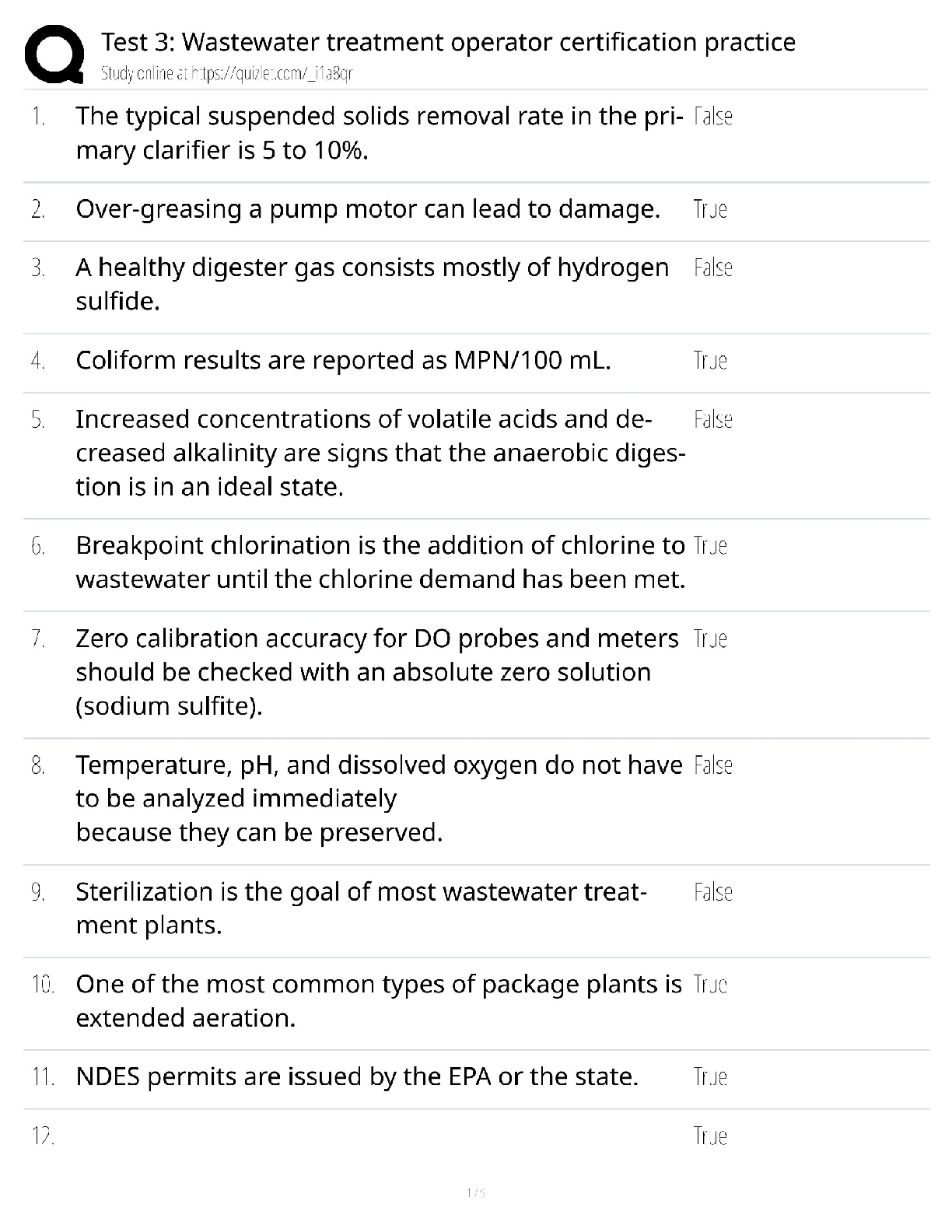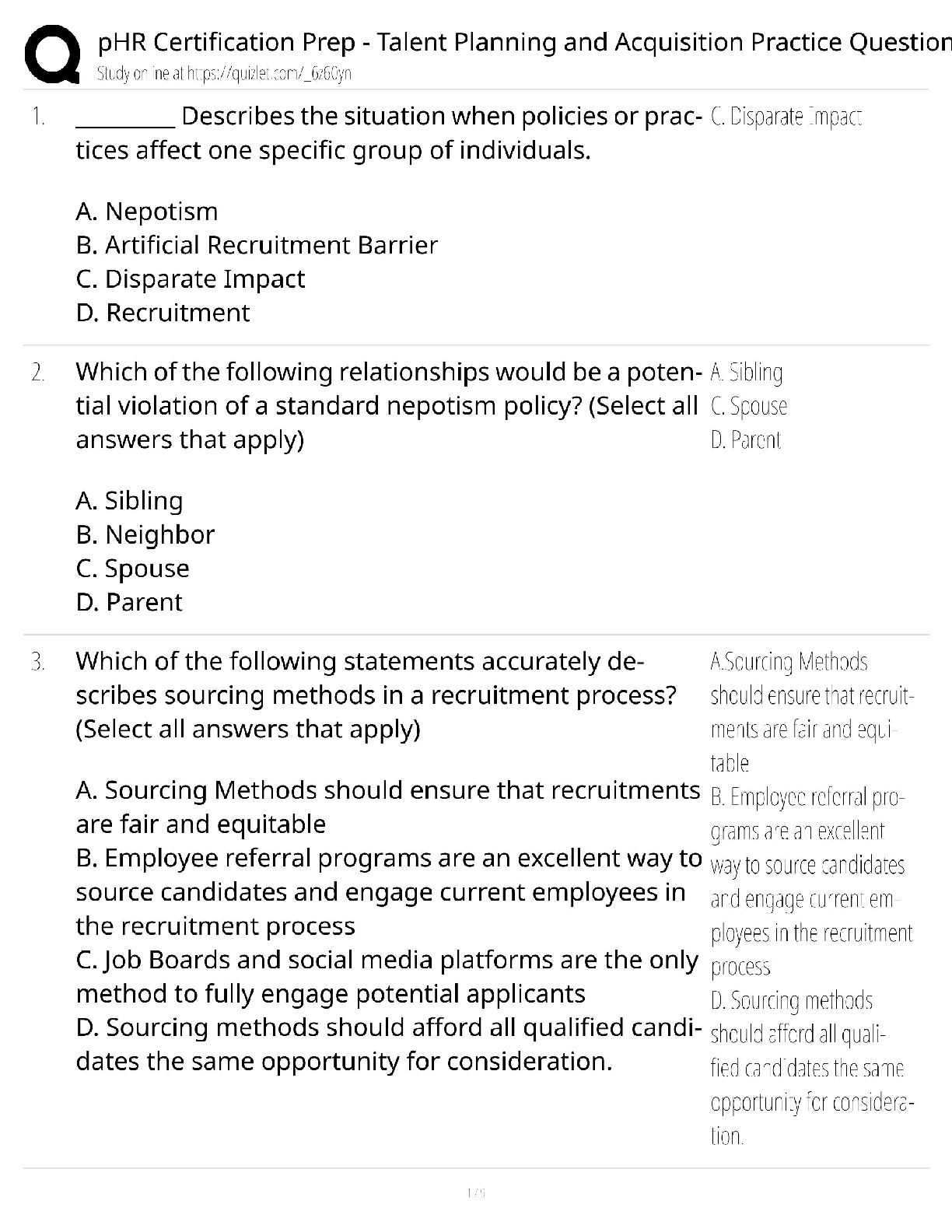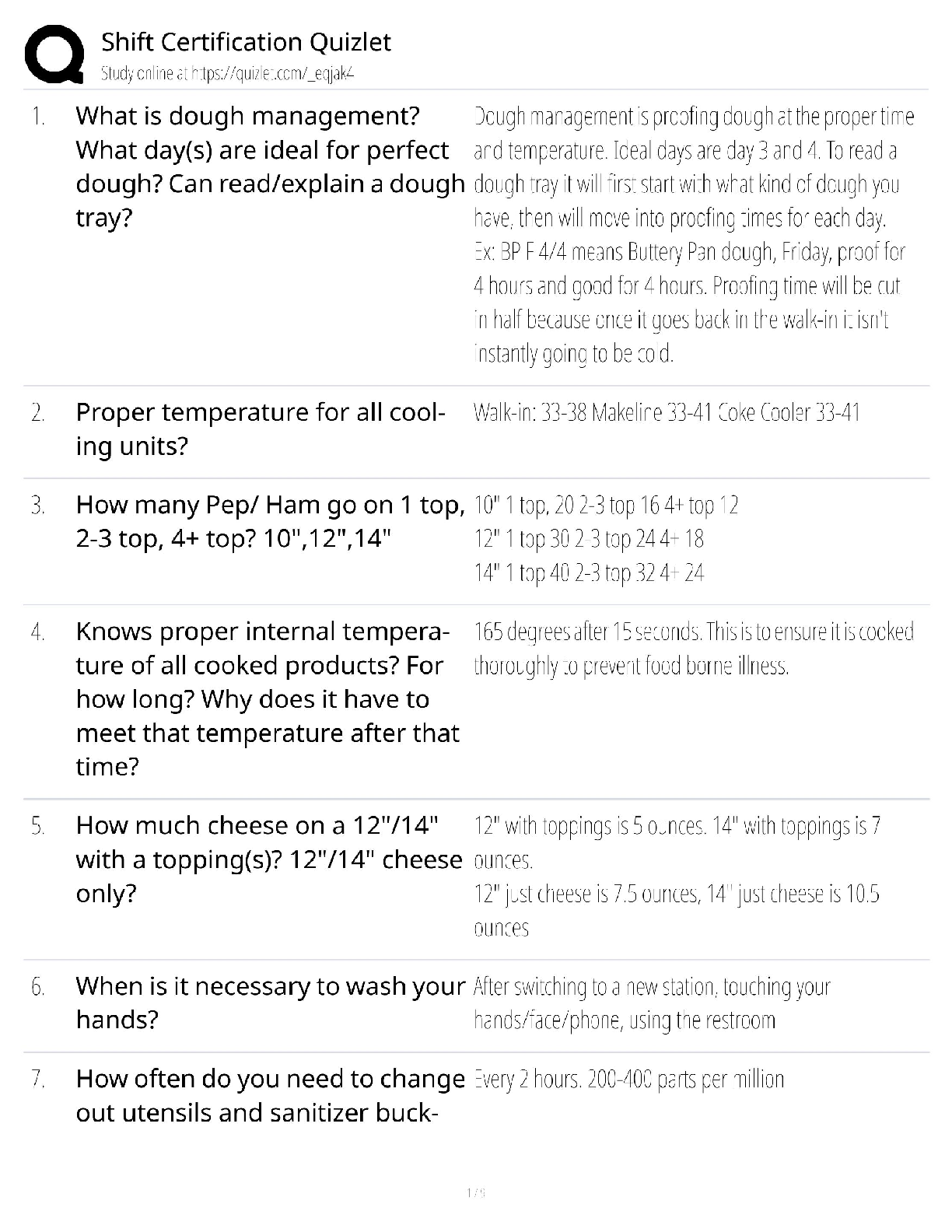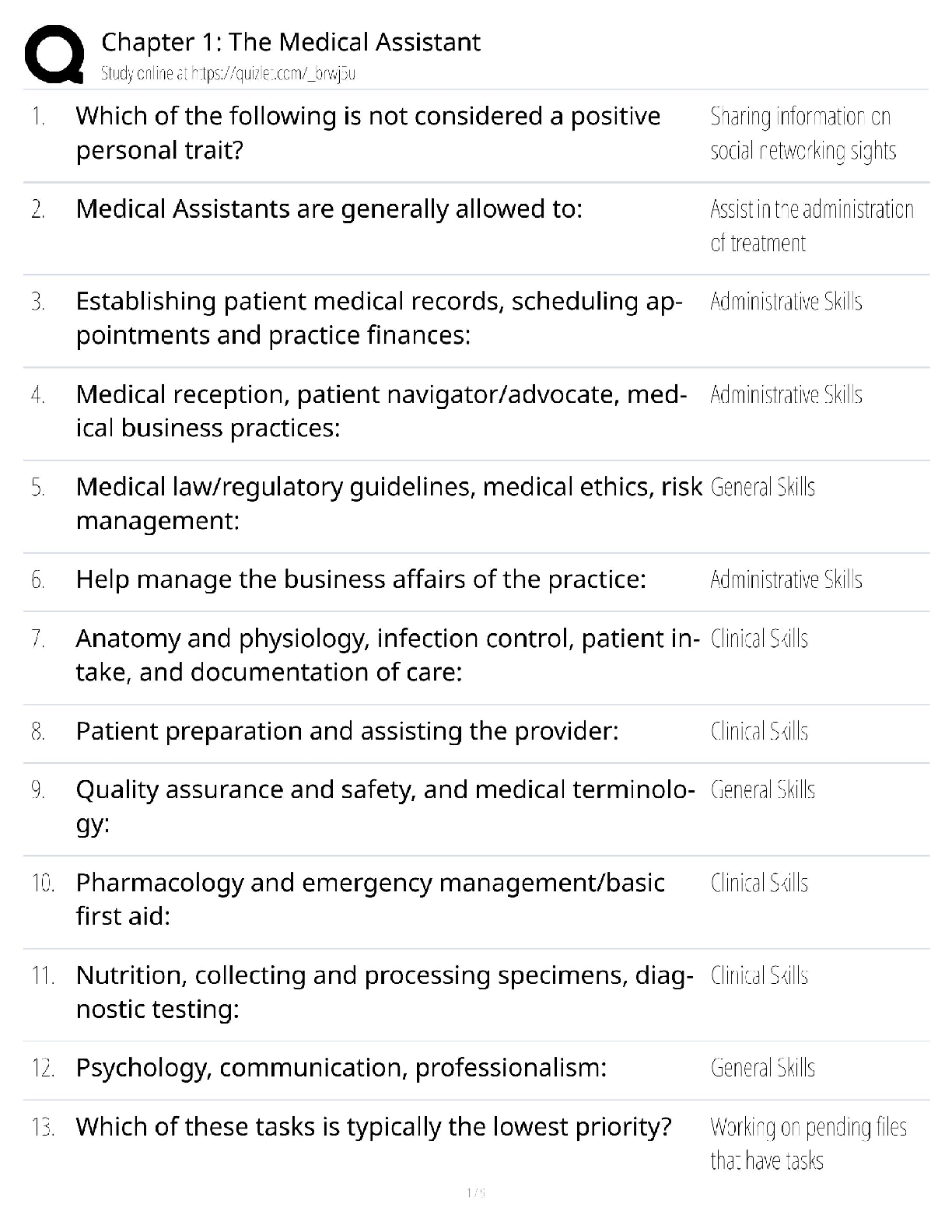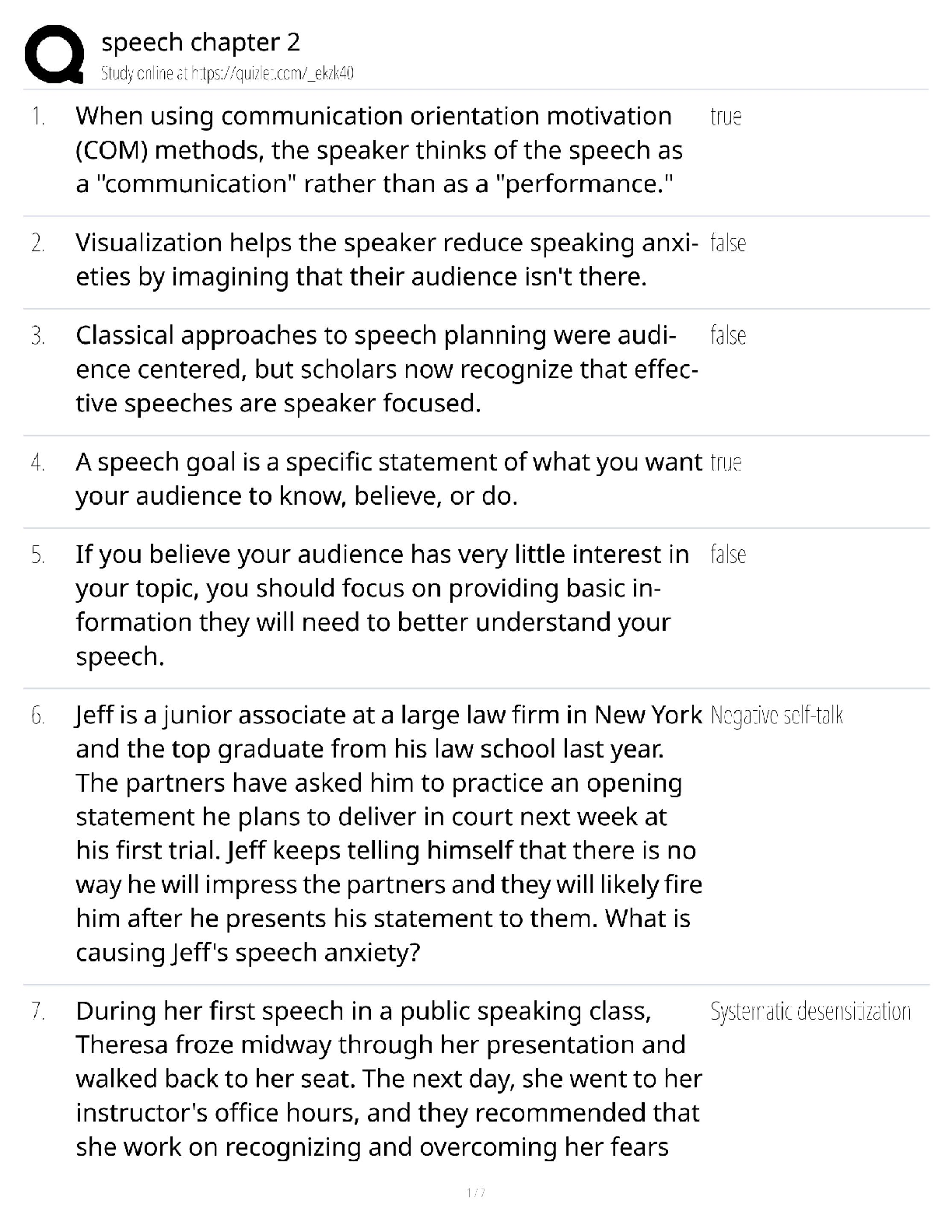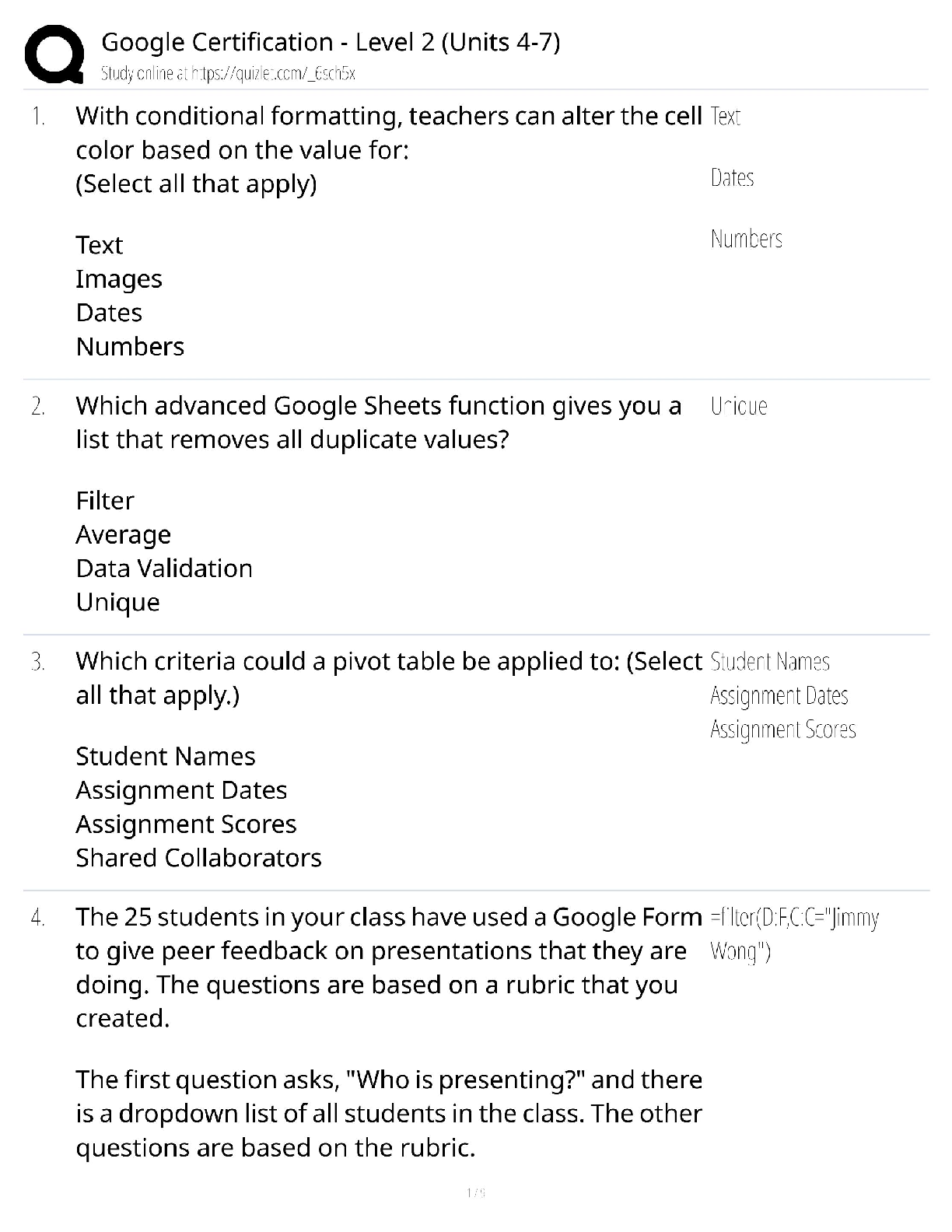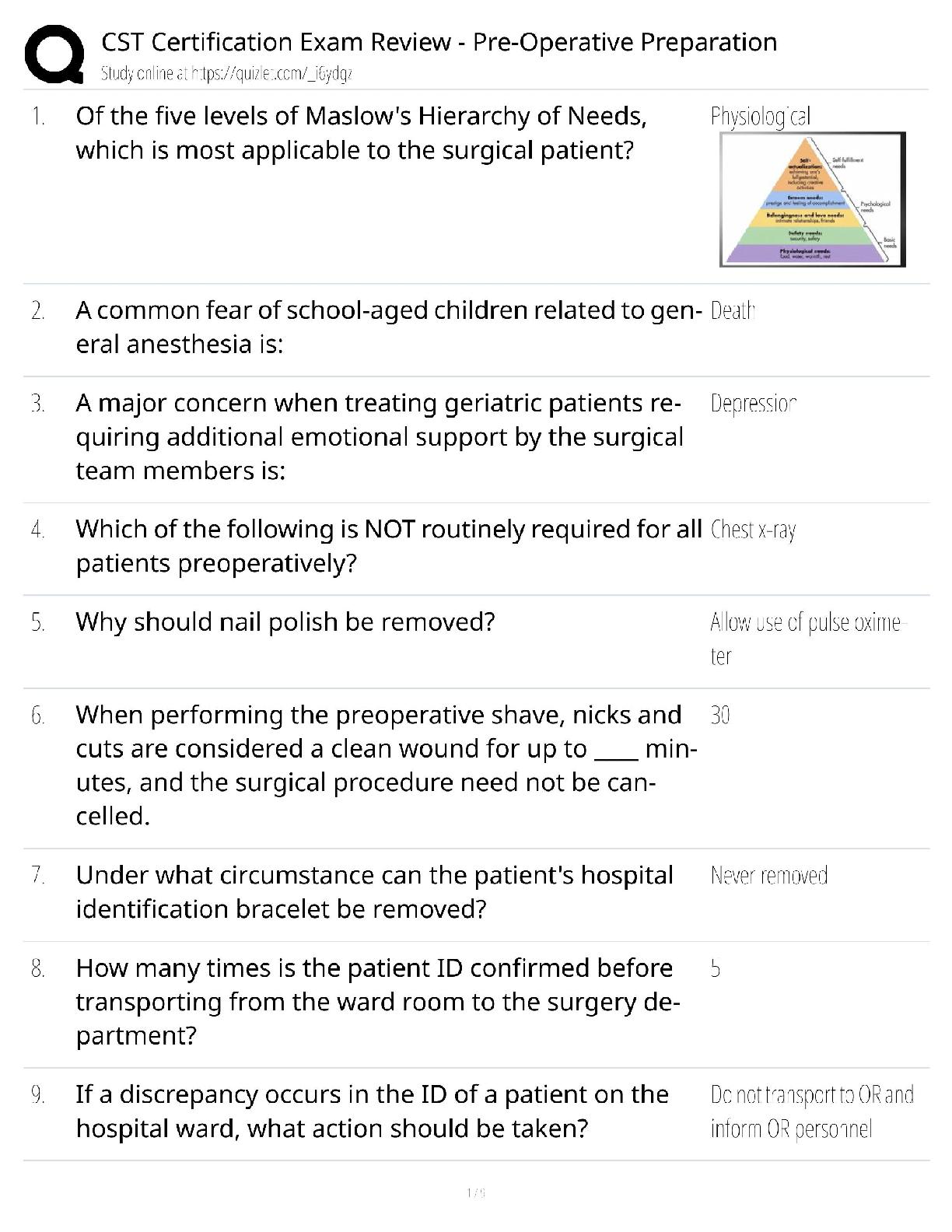Calculus > QUESTIONS & ANSWERS > Stewart - Calculus ET 8e Chapter 9. All Answers (All)
Stewart - Calculus ET 8e Chapter 9. All Answers
Document Content and Description Below
1. is the solution of the differential equation . Find the solution that satisfies the initial condition . 2. A function satisfies the differential equation . What are the constant solutions of the ... equation? 3. A sum of is invested at interest. If is the amount of the investment at time t for the case of continuous compounding, write a differential equation and an initial condition satisfied by . 4. Kirchhoff's Law gives us the derivative equation . If , use Euler's method with step size 0.1 to estimate after 0.3 second. 5. Select a direction field for the differential equation from a set of direction fields labeled I-IV.Stewart - Calculus ET 8e Chapter 9 Form A © 2016 Cengage Learning. All Rights Reserved. May not be scanned, copied or duplicated, or posted to a publicly accessible website, in whole or in part. 6. Find the orthogonal trajectories of the family of curves. 7. Solve the differential equation. 8. A certain small country has $20 billion in paper currency in circulation, and each day $70 million comes into the country's banks. The government decides to introduce new currency by having the banks replace old bills with new ones whenever old currency comes into the banks. Let denote the amount of new currency in circulation at time t with . Formulate and solve a mathematical model in the form of an initial-value problem that represents the ”flow” of the new currency into circulation (in billions per day). 9. Find the solution of the differential equation that satisfies the initial condition . 10. One model for the spread of an epidemic is that the rate of spread is jointly proportional to the number of infected people and the number of uninfected people. In an isolated town of inhabitants, people have a disease at the beginning of the week and have it at the end of the week. How long does it take for of the population to be infected? 11. Let . What are the equilibrium solutions? 12. Biologists stocked a lake with fish and estimated the carrying capacity (the maximal population for the fish of that species in that lake) to be . The number of fish tripled in the first year. Assuming that the size of the fish population satisfies the logistic equation, find an expression for the size of the population after t years. 13. Suppose that a population grows according to a logistic model with carrying capacity and per year. Write the logistic differential equation for these data.Stewart - Calculus ET 8e Chapter 9 Form A © 2016 Cengage Learning. All Rights Reserved. May not be scanned, copied or duplicated, or posted to a publicly accessible website, in whole or in part. 14. Let c be a positive number. A differential equation of the form where k is a positive constant, is called a doomsday equation because the exponent in the expression is larger than the exponent 1for natural growth. An especially prolific breed of rabbits has the growth term . If such rabbits breed initially and the warren has rabbits after months, then when is doomsday? 15. Solve the initial-value problem. 16. Solve the initial-value problem. 17. An object with mass m is dropped from rest and we assume that the air resistance is proportional to the speed of the object. If is the distance dropped after t seconds, then the speed is and the acceleration is . If g is the acceleration due to gravity, then the downward force on the object is , where c is a positive constant, and Newton's Second Law gives . Find the limiting velocity. 18. Solve the initial-value problem. 19. Solve the differential equation. 20. Find the solution of the initial-value problem and use it to find the population when .Stewart - Calculus ET 8e Chapter 9 Form A © 2016 Cengage Learning. All Rights Reserved. May not be scanned, copied or duplicated, or posted to a publicly accessible website, in whole or in part. Answer Key 1. 2. 3. 4. 2.352 5. III 6. 7. 8. 9. 10. 11. 12. 13. 14. 15. 16. 17. 18. 19. 20.Stewart – Calculus ET 8e Chapter 9 Form B © 2016 Cengage Learning. All Rights Reserved. May not be scanned, copied or duplicated, or posted to a publicly accessible website, in whole or in part. 1. Determine whether the differential equation is linear. 2. Solve the differential equation. 3. A phase trajectory is shown for populations of rabbits and foxes . Describe how each population changes as time goes by. Select the correct statement. 4. A population is modeled by the differential equation . For what values of P is the population decreasing? 5. A function satisfies the differential equation . What are the constant solutions of the equation?Stewart – Calculus ET 8e Chapter 9 Form B © 2016 Cengage Learning. All Rights Reserved. May not be scanned, copied or duplicated, or posted to a publicly accessible website, in whole or in part. 6. Kirchhoff's Law gives us the derivative equation . If , use Euler's method with step size 0.1 to estimate after 0.3 second. 7. Select a direction field for the differential equation from a set of direction fields labeled I-IV. 8. Solve the differential equation. 9. A tank contains L of brine with kg of dissolved salt. Pure water enters the tank at a rate of L/min. The solution is kept thoroughly mixed and drains from the tank at the same rate. How much salt is in the tank after minutes? 10. Find the solution of the differential equation that satisfies the initial condition .Stewart – Calculus ET 8e Chapter 9 Form B © 2016 Cengage Learning. All Rights Reserved. May not be scanned, copied or duplicated, or posted to a publicly accessible website, in whole or in part. 11. A certain small country has $20 billion in paper currency in circulation, and each day $70 million comes into the country's banks. The government decides to introduce new currency by having the banks replace old bills with new ones whenever old currency comes into the banks. Let denote the amount of new currency in circulation at time t with . Formulate and solve a mathematical model in the form of an initial-value problem that represents the ”flow” of the new currency into circulation (in billions per day). 12. Find the solution of the differential equation that satisfies the initial condition . 13. Let . What are the equilibrium solutions? 14. Consider the differential equation as a model for a fish population, where t is measured in weeks and c is a constant. For what values of c does the fish population always die out? 15. Biologists stocked a lake with fish and estimated the carrying capacity (the maximal population for the fish of that species in that lake) to be . The number of fish tripled in the first year. Assuming that the size of the fish population satisfies the logistic equation, find an expression for the size of the population after t years. 16. Determine whether the differential equation is linear. 17. Solve the differential equation.Stewart – Calculus ET 8e Chapter 9 Form B © 2016 Cengage Learning. All Rights Reserved. May not be scanned, copied or duplicated, or posted to a publicly accessible website, in whole or in part. 18. Find the solution of the initial-value problem and use it to find the population when . 19. Which equation does the function satisfy? 20. Solve the initial-value problem.Stewart – Calculus ET 8e Chapter 9 Form B © 2016 Cengage Learning. All Rights Reserved. May not be scanned, copied or duplicated, or posted to a publicly accessible website, in whole or in part. Answer Key 1. the equation is linear 2. 3. At the population of foxes reaches a minimum of about 30. 4. 5. 6. 2.352 7. III 8. 9. kg 10. 11. 12. 13. 14. 15. 16. no 17. 18. 19. 20.Stewart – Calculus ET 8e Chapter 9 Form C © 2016 Cengage Learning. All Rights Reserved. May not be scanned, copied or duplicated, or posted to a publicly accessible website, in whole or in part. Select the correct answer for each question. ____ 1. A population is modeled by the differential equation. For what values of P is the population increasing? a. b. c. d. e. ____ 2. Newton's Law of Cooling states that the rate of cooling of an object is proportional to the temperature difference between the object and its surroundings. Suppose that a roast turkey is taken from an oven when its temperature has reached and is placed on a table in a room where the temperature is . If is the temperature of the turkey after t minutes, then Newton's Law of Cooling implies that . This could be solved as a separable differential equation. Another method is to make the change of variable . If the temperature of the turkey is after half an hour, what is the temperature after 35 min? a. b. c. d. e.Stewart – Calculus ET 8e Chapter 9 Form C © 2016 Cengage Learning. All Rights Reserved. May not be scanned, copied or duplicated, or posted to a publicly accessible website, in whole or in part. ____ 3. Solve the differential equation. a. b. c. d. e. ____ 4. Solve the differential equation. a. b. c. d. e.Stewart – Calculus ET 8e Chapter 9 Form C © 2016 Cengage Learning. All Rights Reserved. May not be scanned, copied or duplicated, or posted to a publicly accessible website, in whole or in part. ____ 5. A curve passes through the point and has the property that the slope of the curve at every point P is times the y-coordinate P. What is the equation of the curve? a. b. c. d. e. ____ 6. Solve the differential equation. a. b. c. d. e.Stewart – Calculus ET 8e Chapter 9 Form C © 2016 Cengage Learning. All Rights Reserved. May not be scanned, copied or duplicated, or posted to a publicly accessible website, in whole or in part. ____ 7. Suppose that a population grows according to a logistic model with carrying capacity and per year. Choose the logistic differential equation for these data. a. b. c. d. e. ____ 8. Let c be a positive number. A differential equation of the form where k is a positive constant is called a doomsday equation because the exponent in the expression is larger than the exponent 1 for natural growth. An especially prolific breed of rabbits has the growth term . If such rabbits breed initially and the warren has rabbits after months, then when is doomsday? a. b. c. d. e.Stewart – Calculus ET 8e Chapter 9 Form C © 2016 Cengage Learning. All Rights Reserved. May not be scanned, copied or duplicated, or posted to a publicly accessible website, in whole or in part. ____ 9. The population of the world was about 5.3 billion in 1990. Birth rates in the 1990s range from 35 to 40 million per year and death rates range from 15 to 20 million per year. Let's assume that the carrying capacity for world population is 100 billion. Use the logistic model to predict the world population in the 2,450 year. Calculate your answer in billions to one decimal place. (Because the initial population is small compared to the carrying capacity, you can take k to be an estimate of the initial relative growth rate.) a. 78.3 billion b. 27.0 billion c. 17.1 billion d. 59.2 billion e. 32.9 billion ____ 10. A common inhabitant of human intestines is the bacterium Escherichia coli. A cell of this bacterium in a nutrient-broth medium divides into two cells every . The initial population of a culture is cells. Find the number of cells after hours. a. b. c. d. e. ____ 11. Solve the differential equation. a. b. c. d. e.Stewart – Calculus ET 8e Chapter 9 Form C © 2016 Cengage Learning. All Rights Reserved. May not be scanned, copied or duplicated, or posted to a publicly accessible website, in whole or in part. ____ 12. Solve the differential equation. a. b. c. d. e. ____ 13. Solve the differential equation. a. b. c. d. e.Stewart – Calculus ET 8e Chapter 9 Form C © 2016 Cengage Learning. All Rights Reserved. May not be scanned, copied or duplicated, or posted to a publicly accessible website, in whole or in part. ____ 14. Let be the performance level of someone learning a skill as a function of the training time t. The graph of P is called a learning curve. We propose the differential equation as a reasonable model for learning, where r is a positive constant. Solve it as a linear differential equation. a. b. c. d. e. ____ 15. We modeled populations of aphids and ladybugs with a Lotka-Volterra system. Suppose we modify those equations as follows: , Find the equilibrium solution. a. b. c. d. e.Stewart – Calculus ET 8e Chapter 9 Form C © 2016 Cengage Learning. All Rights Reserved. May not be scanned, copied or duplicated, or posted to a publicly accessible website, in whole or in part. ____ 16. A phase trajectory is shown for populations of rabbits and foxes . Describe how each population changes as time goes by. Select the correct statement. a. At the number of rabbits rebounds to 500. b. At the number of foxes reaches a maximum of about 2400. c. At the population of foxes reaches a minimum of about 30. ____ 17. For what values of k does the function satisfy the differential equation ? a. b. c. d. e.Stewart – Calculus ET 8e Chapter 9 Form C © 2016 Cengage Learning. All Rights Reserved. May not be scanned, copied or duplicated, or posted to a publicly accessible website, in whole or in part. ____ 18. For what nonzero values of k does the function satisfy the differential equation for all values of A and B? a. b. c. d. e. ____ 19. Which of the following functions are the constant solutions of the equation a. b. c. d. e. ____ 20. Which of the following functions is a solution of the differential equation? a. b. c. d. e.Stewart – Calculus ET 8e Chapter 9 Form C © 2016 Cengage Learning. All Rights Reserved. May not be scanned, copied or duplicated, or posted to a publicly accessible website, in whole or in part. Answer Key 1. D 2. B 3. C 4. D 5. D 6. C 7. E 8. C 9. B 10. D 11. A 12. B 13. D 14. B 15. D 16. C 17. C, E 18. A, C 19. A, B, D 20. B, C, DStewart – Calculus ET 8e Chapter 9 Form D © 2016 Cengage Learning. All Rights Reserved. May not be scanned, copied or duplicated, or posted to a publicly accessible website, in whole or in part. Select the correct answer for each question. ____ 1. Which equation does the function satisfy? a. b. c. d. e. ____ 2. Newton's Law of Cooling states that the rate of cooling of an object is proportional to the temperature difference between the object and its surroundings. Suppose that a roast turkey is taken from an oven when its temperature has reached and is placed on a table in a room where the temperature is . If is the temperature of the turkey after t minutes, then Newton's Law of Cooling implies that . This could be solved as a separable differential equation. Another method is to make the change of variable . If the temperature of the turkey is after half an hour, what is the temperature after 35 min? a. b. c. d. e. ____ 3. Use Euler's method with step size 0.25 to estimate , where is the solution of the initial-value problem. Round your answer to four decimal places. a. b. c. d. e.Stewart – Calculus ET 8e Chapter 9 Form D © 2016 Cengage Learning. All Rights Reserved. May not be scanned, copied or duplicated, or posted to a publicly accessible website, in whole or in part. ____ 4. Choose the differential equation corresponding to this direction field. a. b. c. d. e. ____ 5. Solve the differential equation. a. b. c. d. e.Stewart – Calculus ET 8e Chapter 9 Form D © 2016 Cengage Learning. All Rights Reserved. May not be scanned, copied or duplicated, or posted to a publicly accessible website, in whole or in part. ____ 6. A curve passes through the point and has the property that the slope of the curve at every point P is times the y-coordinate P. What is the equation of the curve? a. b. c. d. e. ____ 7. Find the orthogonal trajectories of the family of curves. a. b. c. d. e. ____ 8. Suppose that a population develops according to the logistic equation , where t is measured in weeks. What is the carrying capacity? a. b. c. d. e.Stewart – Calculus ET 8e Chapter 9 Form D © 2016 Cengage Learning. All Rights Reserved. May not be scanned, copied or duplicated, or posted to a publicly accessible website, in whole or in part. ____ 9. Suppose that a population grows according to a logistic model with carrying capacity and per year. Choose the logistic differential equation for these data. a. b. c. d. e. ____ 10. A sum of is invested at interest. If is the amount of the investment at time t for the case of continuous compounding, write a differential equation and an initial condition satisfied by . a. b. c. d. e.Stewart – Calculus ET 8e Chapter 9 Form D © 2016 Cengage Learning. All Rights Reserved. May not be scanned, copied or duplicated, or posted to a publicly accessible website, in whole or in part. ____ 11. Let c be a positive number. A differential equation of the form where k is a positive constant is called a doomsday equation because the exponent in the expression is larger than the exponent 1 for natural growth. An especially prolific breed of rabbits has the growth term . If such rabbits breed initially and the warren has rabbits after months, then when is doomsday? a. b. c. d. e. ____ 12. The population of the world was about 5.3 billion in 1990. Birth rates in the 1990s range from 35 to 40 million per year and death rates range from 15 to 20 million per year. Let's assume that the carrying capacity for world population is 100 billion. Use the logistic model to predict the world population in the 2,450 year. Calculate your answer in billions to one decimal place. (Because the initial population is small compared to the carrying capacity, you can take k to be an estimate of the initial relative growth rate.) a. 78.3 billion b. 27.0 billion c. 17.1 billion d. 59.2 billion e. 32.9 billion ____ 13. A common inhabitant of human intestines is the bacterium Escherichia coli. A cell of this bacterium in a nutrient-broth medium divides into two cells every . The initial population of a culture is cells. Find the number of cells after hours. a. b. c. d. e.Stewart – Calculus ET 8e Chapter 9 Form D © 2016 Cengage Learning. All Rights Reserved. May not be scanned, copied or duplicated, or posted to a publicly accessible website, in whole or in part. ____ 14. Solve the initial-value problem. a. b. c. d. e. ____ 15. Solve the initial-value problem. a. b. c. d. e.Stewart – Calculus ET 8e Chapter 9 Form D © 2016 Cengage Learning. All Rights Reserved. May not be scanned, copied or duplicated, or posted to a publicly accessible website, in whole or in part. ____ 16. Solve the differential equation. a. b. c. d. e. ____ 17. Solve the initial-value problem. a. b. c. d. e. ____ 18. Determine whether the differential equation is linear. a. the equation is not linear b. the equation is linearStewart – Calculus ET 8e Chapter 9 Form D © 2016 Cengage Learning. All Rights Reserved. May not be scanned, copied or duplicated, or posted to a publicly accessible website, in whole or in part. ____ 19. Solve the differential equation. a. b. c. d. e. ____ 20. Solve the initial-value problem. a. b. c. d. e.Stewart – Calculus ET 8e Chapter 9 Form D © 2016 Cengage Learning. All Rights Reserved. May not be scanned, copied or duplicated, or posted to a publicly accessible website, in whole or in part. Answer Key 1. B 2. B 3. B 4. B 5. B 6. E 7. E 8. A 9. E 10. E 11. A 12. B 13. B 14. B 15. C 16. C 17. B 18. B 19. D 20. DStewart – Calculus ET 8e Chapter 9 Form E © 2016 Cengage Learning. All Rights Reserved. May not be scanned, copied or duplicated, or posted to a publicly accessible website, in whole or in part. 1. A population is modeled by the differential equation. For what values of P is the population increasing? ____ 2. Choose the differential equation corresponding to this direction field. Select the correct answer. a. b. c. d. e. 3. Solve the differential equation. 4. A curve passes through the point and has the property that the slope of the curve at every point P is times the y-coordinate P. What is the equation of the curve? 5. Solve the differential equation.Stewart – Calculus ET 8e Chapter 9 Form E © 2016 Cengage Learning. All Rights Reserved. May not be scanned, copied or duplicated, or posted to a publicly accessible website, in whole or in part. ____ 6. Suppose that a population develops according to the logistic equation , where t is measured in weeks. What is the carrying capacity? Select the correct answer. a. b. c. d. e. 7. Suppose that a population grows according to a logistic model with carrying capacity and per year. Choose the logistic differential equation for these data. ____ 8. One model for the spread of an epidemic is that the rate of spread is jointly proportional to the number of infected people and the number of uninfected people. In an isolated town of inhabitants, people have a disease at the beginning of the week and have it at the end of the week. How long does it take for of the population to be infected? Select the correct answer. a. b. c. d. e. 9. A sum of is invested at interest. If is the amount of the investment at time t for the case of continuous compounding, write a differential equation and an initial condition satisfied by .Stewart – Calculus ET 8e Chapter 9 Form E © 2016 Cengage Learning. All Rights Reserved. May not be scanned, copied or duplicated, or posted to a publicly accessible website, in whole or in part. 10. Let c be a positive number. A differential equation of the form where k is a positive constant is called a doomsday equation because the exponent in the expression is larger than the exponent 1 for natural growth. An especially prolific breed of rabbits has the growth term . If such rabbits breed initially and the warren has rabbits after months, then when is doomsday? ____ 11. The population of the world was about 5.3 billion in 1990. Birth rates in the 1990s range from 35 to 40 million per year and death rates range from 15 to 20 million per year. Let's assume that the carrying capacity for world population is 100 billion. Use the logistic model to predict the world population in the 2,450 year. Calculate your answer in billions to one decimal place. (Because the initial population is small compared to the carrying capacity, you can take k to be an estimate of the initial relative growth rate.) Select the correct answer. a. 78.3 billion b. 27.0 billion c. 17.1 billion d. 59.2 billion e. 32.9 billion 12. Consider a population with constant relative birth and death rates and , respectively, and a constant emigration rate m, where , and . Then the rate of change of the population at time t is modeled by the differential equation where . Find the solution of this equation with the rate of change of the population at time that satisfies the initial condition . 13. Solve the initial-value problem.Stewart – Calculus ET 8e Chapter 9 Form E © 2016 Cengage Learning. All Rights Reserved. May not be scanned, copied or duplicated, or posted to a publicly accessible website, in whole or in part. 14. Solve the initial-value problem. 15. Solve the differential equation. ____ 16. Determine whether the differential equation is linear. Select the correct answer. a. the equation is linear b. the equation is not linear 17. In the circuit shown in Figure, a generator supplies a voltage of volts, the inductance is 2 H, the resistance is 40 , and . Find the current 0.2 s after the switch is closed. Round your answer to two decimal places. ____ 18. Solve the differential equation. Select the correct answer. a. b. c. d. e.Stewart – Calculus ET 8e Chapter 9 Form E © 2016 Cengage Learning. All Rights Reserved. May not be scanned, copied or duplicated, or posted to a publicly accessible website, in whole or in part. 19. Let be the performance level of someone learning a skill as a function of the training time t. The graph of P is called a learning curve. We propose the differential equation as a reasonable model for learning, where r is a positive constant. Solve it as a linear differential equation. 20. We modeled populations of aphids and ladybugs with a Lotka-Volterra system. Suppose we modify those equations as follows: , Find the equilibrium solution.Stewart – Calculus ET 8e Chapter 9 Form E © 2016 Cengage Learning. All Rights Reserved. May not be scanned, copied or duplicated, or posted to a publicly accessible website, in whole or in part. Answer Key 1. 2. E 3. 4. 5. 6. C 7. 8. D 9. 10. 11. B 12. 13. 14. 15. 16. A 17. 18. D 19. 20.Stewart - Calculus ET 8e Chapter 9 Form F © 2016 Cengage Learning. All Rights Reserved. May not be scanned, copied or duplicated, or posted to a publicly accessible website, in whole or in part. ____ 1. A population is modeled by the differential equation. For what values of P is the population increasing? Select the correct answer. a. b. c. d. e. 2. Solve the initial-value problem. 3. Newton's Law of Cooling states that the rate of cooling of an object is proportional to the temperature difference between the object and its surroundings. Suppose that a roast turkey is taken from an oven when its temperature has reached and is placed on a table in a room where the temperature is . If is the temperature of the turkey after t minutes, then Newton's Law of Cooling implies that . This could be solved as a separable differential equation. Another method is to make the change of variable . If the temperature of the turkey is after half an hour, what is the temperature after 35 min? ____ 4. Use Euler's method with step size 0.25 to estimate , where is the solution of the initial-value problem. Round your answer to four decimal places. Select the correct answer. a. b. c. d. e.Stewart - Calculus ET 8e Chapter 9 Form F © 2016 Cengage Learning. All Rights Reserved. May not be scanned, copied or duplicated, or posted to a publicly accessible website, in whole or in part. 5. Choose the differential equation corresponding to this direction field. 6. Solve the differential equation. 7. A curve passes through the point and has the property that the slope of the curve at every point P is times the y-coordinate P. What is the equation of the curve? 8. Suppose that a population develops according to the logistic equation , where t is measured in weeks. What is the carrying capacity? ____ 9. One model for the spread of an epidemic is that the rate of spread is jointly proportional to the number of infected people and the number of uninfected people. In an isolated town of inhabitants, people have a disease at the beginning of the week and have it at the end of the week. How long does it take for of the population to be infected? Select the correct answer. a. b. c. d. e.Stewart - Calculus ET 8e Chapter 9 Form F © 2016 Cengage Learning. All Rights Reserved. May not be scanned, copied or duplicated, or posted to a publicly accessible website, in whole or in part. 10. A sum of is invested at interest. If is the amount of the investment at time t for the case of continuous compounding, write a differential equation and an initial condition satisfied by . 11. Consider a population with constant relative birth and death rates and , respectively, and a constant emigration rate m, where , and . Then the rate of change of the population at time t is modeled by the differential equation where . Find the solution of this equation with the rate of change of the population at time that satisfies the initial condition . 12. Solve the initial-value problem. ____ 13. Solve the differential equation. Select the correct answer. a. b. c. d. e.Stewart - Calculus ET 8e Chapter 9 Form F © 2016 Cengage Learning. All Rights Reserved. May not be scanned, copied or duplicated, or posted to a publicly accessible website, in whole or in part. 14. Solve the initial-value problem. ____ 15. Determine whether the differential equation is linear. Select the correct answer. a. the equation is linear b. the equation is not linear 16. In the circuit shown in Figure, a generator supplies a voltage of volts, the inductance is 2 H, the resistance is 40 , and . Find the current 0.2 s after the switch is closed. Round your answer to two decimal places. 17. Solve the differential equation. 18. Solve the differential equation. 19. Let be the performance level of someone learning a skill as a function of the training time t. The graph of P is called a learning curve. We propose the differential equation as a reasonable model for learning, where r is a positive constant. Solve it as a linear differential equation.Stewart - Calculus ET 8e Chapter 9 Form F © 2016 Cengage Learning. All Rights Reserved. May not be scanned, copied or duplicated, or posted to a publicly accessible website, in whole or in part. ____ 20. A phase trajectory is shown for populations of rabbits and foxes . Describe how each population changes as time goes by. Select the correct statement. a. At the number of rabbits rebounds to 500. b. At the number of foxes reaches a maximum of about 2400. c. At the population of foxes reaches a minimum of about 30.Stewart - Calculus ET 8e Chapter 9 Form F © 2016 Cengage Learning. All Rights Reserved. May not be scanned, copied or duplicated, or posted to a publicly accessible website, in whole or in part. Answer Key 1. D 2. 3. 4. D 5. 6. 7. 8. 9. C 10. 11. 12. 13. E 14. 15. A 16. 17. 18. 19. 20. CStewart – Calculus ET 8e Chapter 8 Form G © 2016 Cengage Learning. All Rights Reserved. May not be scanned, copied or duplicated, or posted to a publicly accessible website, in whole or in part. ____ 1. Which equation does the function satisfy? Select the correct answer. a. b. c. d. e. 2. Solve the initial-value problem. ____ 3. Newton's Law of Cooling states that the rate of cooling of an object is proportional to the temperature difference between the object and its surroundings. Suppose that a roast turkey is taken from an oven when its temperature has reached and is placed on a table in a room where the temperature is . If is the temperature of the turkey after t minutes, then Newton's Law of Cooling implies that . This could be solved as a separable differential equation. Another method is to make the change of variable . If the temperature of the turkey is after half an hour, what is the temperature after 35 min? Select the correct answer. a. b. c. d. e. 4. Solve the differential equation. 5. A curve passes through the point and has the property that the slope of the curve at every point P is times the y-coordinate P. What is the equation of the curve? 6. Find the orthogonal trajectories of the family of curves.Stewart – Calculus ET 8e Chapter 8 Form G © 2016 Cengage Learning. All Rights Reserved. May not be scanned, copied or duplicated, or posted to a publicly accessible website, in whole or in part. 7. Solve the differential equation. ____ 8. Suppose that a population develops according to the logistic equation , where t is measured in weeks. What is the carrying capacity? Select the correct answer. a. b. c. d. e. 9. One model for the spread of an epidemic is that the rate of spread is jointly proportional to the number of infected people and the number of uninfected people. In an isolated town of inhabitants, people have a disease at the beginning of the week and have it at the end of the week. How long does it take for of the population to be infected? 10. Let c be a positive number. A differential equation of the form where k is a positive constant is called a doomsday equation because the exponent in the expression is larger than the exponent 1 for natural growth. An especially prolific breed of rabbits has the growth term . If such rabbits breed initially and the warren has rabbits after months, then when is doomsday?Stewart – Calculus ET 8e Chapter 8 Form G © 2016 Cengage Learning. All Rights Reserved. May not be scanned, copied or duplicated, or posted to a publicly accessible website, in whole or in part. ____ 11. The population of the world was about 5.3 billion in 1990. Birth rates in the 1990s range from 35 to 40 million per year and death rates range from 15 to 20 million per year. Let's assume that the carrying capacity for world population is 100 billion. Use the logistic model to predict the world population in the 2,450 year. Calculate your answer in billions to one decimal place. (Because the initial population is small compared to the carrying capacity, you can take k to be an estimate of the initial relative growth rate.) Select the correct answer. a. 78.3 billion b. 27.0 billion c. 17.1 billion d. 59.2 billion e. 32.9 billion 12. A common inhabitant of human intestines is the bacterium Escherichia coli. A cell of this bacterium in a nutrient-broth medium divides into two cells every . The initial population of a culture is cells. Find the number of cells after hours. 13. Solve the initial-value problem. 14. Solve the differential equation. ____ 15. Solve the initial-value problem. Select the correct answer. a. b. c. d. e.Stewart – Calculus ET 8e Chapter 8 Form G © 2016 Cengage Learning. All Rights Reserved. May not be scanned, copied or duplicated, or posted to a publicly accessible website, in whole or in part. ____ 16. Determine whether the differential equation is linear. Select the correct answer. a. the equation is linear b. the equation is not linear 17. In the circuit shown in Figure, a generator supplies a voltage of volts, the inductance is 2 H, the resistance is 40 , and . Find the current 0.2 s after the switch is closed. Round your answer to two decimal places. 18. Solve the differential equation.Stewart – Calculus ET 8e Chapter 8 Form G © 2016 Cengage Learning. All Rights Reserved. May not be scanned, copied or duplicated, or posted to a publicly accessible website, in whole or in part. ____ 19. Solve the differential equation. Select the correct answer. a. b. c. d. e. 20. We modeled populations of aphids and ladybugs with a Lotka-Volterra system. Suppose we modify those equations as follows: , Find the equilibrium solution.Stewart – Calculus ET 8e Chapter 8 Form G © 2016 Cengage Learning. All Rights Reserved. May not be scanned, copied or duplicated, or posted to a publicly accessible website, in whole or in part. Answer Key 1. C 2. 3. B 4. 5. 6. 7. 8. D 9. 10. 11. B 12. 13. 14. 15. A 16. A 17. 18. 19. D 20.Stewart - Calculus ET 8e Chapter 9 Form H © 2016 Cengage Learning. All Rights Reserved. May not be scanned, copied or duplicated, or posted to a publicly accessible website, in whole or in part. ____ 1. Which equation does the function satisfy? Select the correct answer. a. b. c. d. e. 2. A population is modeled by the differential equation. For what values of P is the population increasing? 3. Use Euler's method with step size 0.25 to estimate , where is the solution of the initial-value problem. Round your answer to four decimal places. 4. Solve the differential equation. ____ 5. Solve the differential equation. Select the correct answer. a. b. c. d. e. 6. Find the orthogonal trajectories of the family of curves.Stewart - Calculus ET 8e Chapter 9 Form H © 2016 Cengage Learning. All Rights Reserved. May not be scanned, copied or duplicated, or posted to a publicly accessible website, in whole or in part. 7. Suppose that a population develops according to the logistic equation , where t is measured in weeks. What is the carrying capacity? 8. A sum of is invested at interest. If is the amount of the investment at time t for the case of continuous compounding, write a differential equation and an initial condition satisfied by . ____ 9. Let c be a positive number. A differential equation of the form where k is a positive constant is called a doomsday equation because the exponent in the expression is larger than the exponent 1 for natural growth. An especially prolific breed of rabbits has the growth term . If such rabbits breed initially and the warren has rabbits after months, then when is doomsday? Select the correct answer. a. b. c. d. e. 10. A common inhabitant of human intestines is the bacterium Escherichia coli. A cell of this bacterium in a nutrient-broth medium divides into two cells every . The initial population of a culture is cells. Find the number of cells after hours.Stewart - Calculus ET 8e Chapter 9 Form H © 2016 Cengage Learning. All Rights Reserved. May not be scanned, copied or duplicated, or posted to a publicly accessible website, in whole or in part. 11. Consider a population with constant relative birth and death rates and , respectively, and a constant emigration rate m, where , and . Then the rate of change of the population at time t is modeled by the differential equation where . Find the solution of this equation with the rate of change of the population at time that satisfies the initial condition . ____ 12. Solve the initial-value problem. Select the correct answer. a. b. c. d. e. 13. Solve the differential equation. 14. Solve the initial-value problem. ____ 15. Determine whether the differential equation is linear. Select the correct answer. a. the equation is linear b. the equation is not linear 16. Solve the differential equation.Stewart - Calculus ET 8e Chapter 9 Form H © 2016 Cengage Learning. All Rights Reserved. May not be scanned, copied or duplicated, or posted to a publicly accessible website, in whole or in part. 17. Solve the differential equation. 18. Let be the performance level of someone learning a skill as a function of the training time t. The graph of P is called a learning curve. We propose the differential equation as a reasonable model for learning, where r is a positive constant. Solve it as a linear differential equation. 19. We modeled populations of aphids and ladybugs with a Lotka-Volterra system. Suppose we modify those equations as follows: , Find the equilibrium solution.Stewart - Calculus ET 8e Chapter 9 Form H © 2016 Cengage Learning. All Rights Reserved. May not be scanned, copied or duplicated, or posted to a publicly accessible website, in whole or in part. ____ 20. A phase trajectory is shown for populations of rabbits and foxes . Describe how each population changes as time goes by. Select the correct answer. Select the correct statement. a. At the number of rabbits rebounds to 500. b. At the number of foxes reaches a maximum of about 2400. c. At the population of foxes reaches a minimum of about 30.Stewart - Calculus ET 8e Chapter 9 Form H © 2016 Cengage Learning. All Rights Reserved. May not be scanned, copied or duplicated, or posted to a publicly accessible website, in whole or in part. Answer Key 1. E 2. 3. 4. 5. D 6. 7. 8. 9. E 10. 11. 12. C 13. 14. 15. A 16. 17. 18. 19. 20. C [Show More]
Last updated: 3 years ago
Preview 1 out of 52 pages
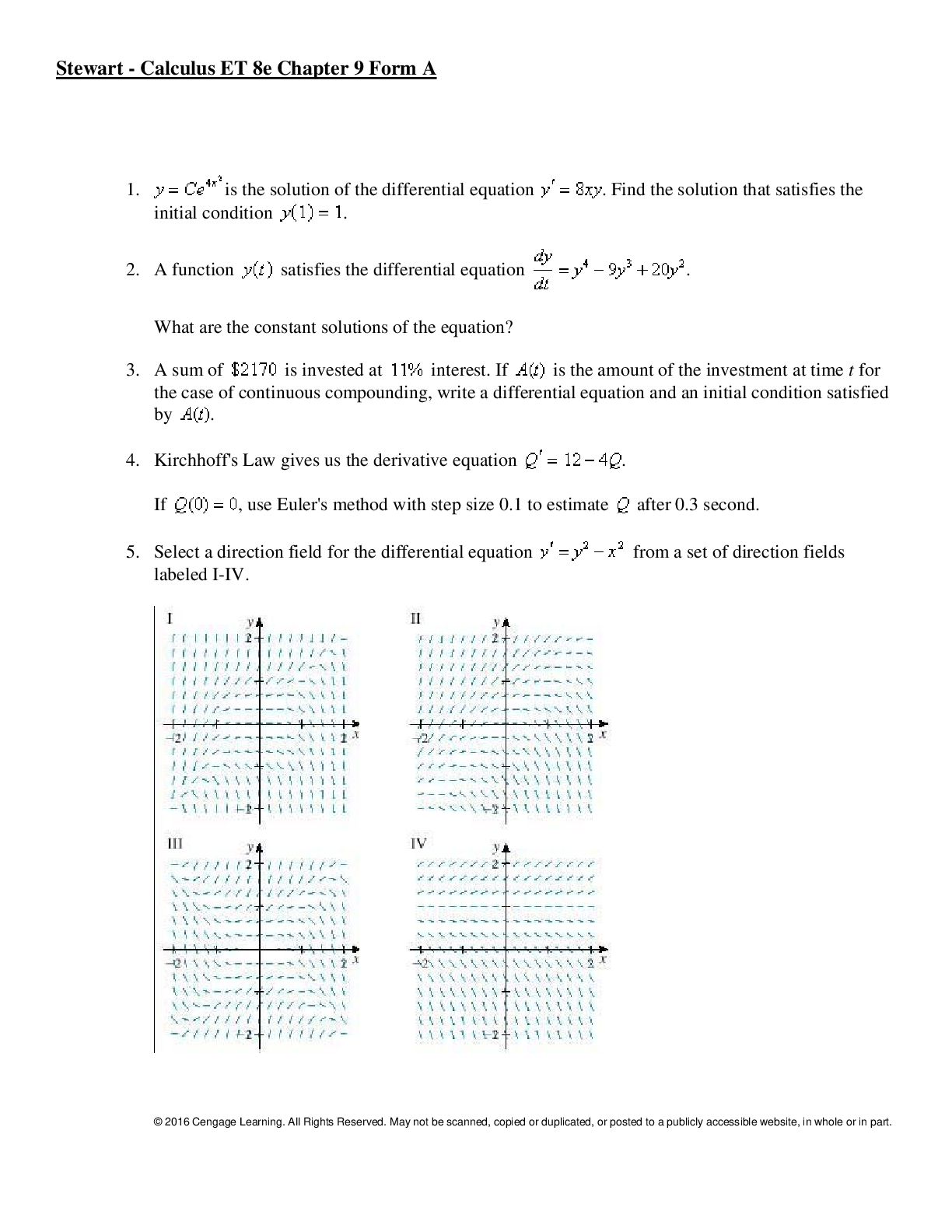
Buy this document to get the full access instantly
Instant Download Access after purchase
Buy NowInstant download
We Accept:

Reviews( 0 )
$10.00
Can't find what you want? Try our AI powered Search
Document information
Connected school, study & course
About the document
Uploaded On
Jan 15, 2020
Number of pages
52
Written in
All
Additional information
This document has been written for:
Uploaded
Jan 15, 2020
Downloads
0
Views
114




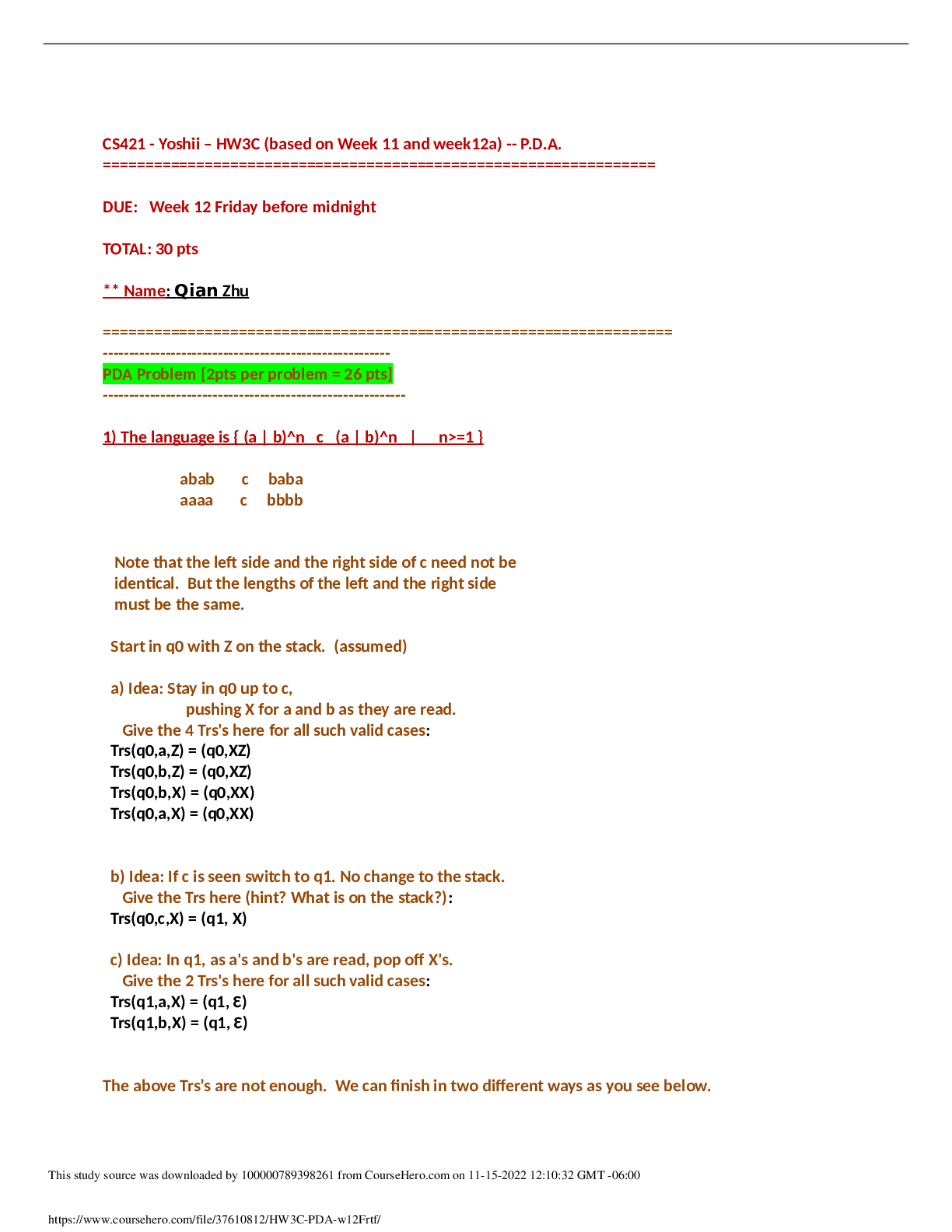


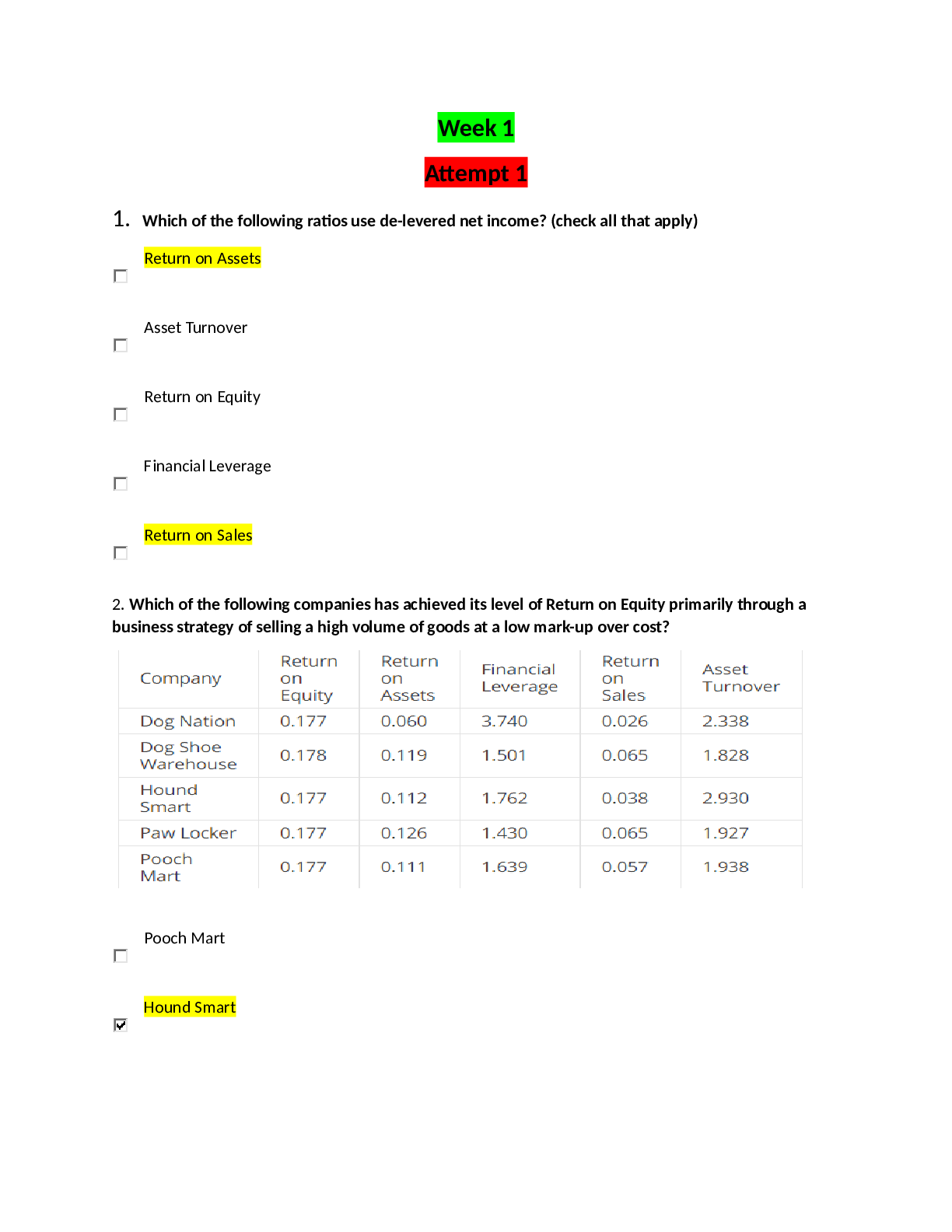
.png)
.png)
.png)
.png)
.png)



